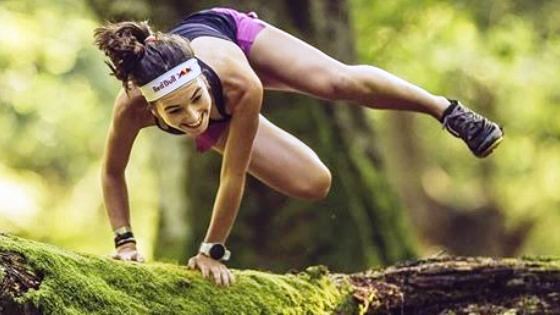
I was puffing my way to the top of the brutally steep trail near my mountain village, the inside of my head thumping in tune with my heart rate. The thought crossed my mind that Courtney Dauwalter can run faster than this and keep going for 58 hours almost without stopping. I needed to find a way to be able to trail run without getting this tired so that I, too, could keep smiling like Courtney.
How to trail run without getting tired? Preparing your body ahead of time for the task at hand in terms of health, nutrition, and hydration is an important first step to not getting tired. Add to that the moderation of your effort as well as optimizing recovery and you are set for making your trail runs less tiring.
By its very nature trail running is a tiring activity. Unlike what many may say, it is an all body sport and will pummel you if given the chance. All that being said, running, especially running on trails is a skill that we should all be able to master as it was one that our ancestors did well.
At a superficial level trail running is a great path to an overall healthy lifestyle. For many, including me, it is a great way to keep our weight under control. Let’s take a closer look at what you can do before, during and after each run that will help you be able to trail run without getting tired.
Before During and After
The hot tips for how to trail run without getting tired can be split into three key areas. Tips for before each trail run. Tips for during each trail run. And finally tips for after each trail run.
The final group of tips is no less important than the first two groups as that is what will help your next trail run to be less tiring.
- Before your trail run
- During your trail run
- After your trail run
Let’s take a closer look at each of the tips that will help you avoid getting fatigued in more detail.
1. Before Your Trail Run
Before we can to the tips you can follow during your trail run it is important to cover what you can do before you even hit the trail.
1.1 Stay Healthy
It may seem completely inane, but it is key to be able to trail run without getting tired. Try to hit the trails when you are unwell and you will be reduced to a grovel in pretty short order.
Conversely, your endurance fitness is something that is built up over time. A healthy body will recover faster allowing you to do more training more often. Any health setback will be a fitness setback.
When it comes to staying healthy, all the usual standards will apply. Make sure that your nutrition is packed with lots of fresh fruit and vegetables, drink plenty of water and do your best to avoid junk and processed food. An additional spin-off from having a healthy nutrition strategy is that it will keep your weight from getting away from you and that will help you to trail run without getting tired, especially on the hills.

1.2 Cross Training
In theory, it is something that everyone knows that they should do, but in practice not so much because it is so much more fun being out on the trails. No matter whether trail running is your main sport or even your only sport, you will do better by including some other ways to keep fit.
The cliche cross-training activities that will build your endurance are of course swimming and cycling. In addition to these, you will do well incorporating strength work at the gym.
When it comes to cross-training the most important factor that will impact on not getting tired during your trail runs will be core work. Trail running does relatively little to improve your core strength. However, if you have a strong core you will be able to maintain good posture for longer. This will make your trail running massively less tiring.
1.3 Warming Up
No matter what type of physical activity you plan to do, a good warm-up will be essential to ensuring that muscles function optimally.
Failing to do a warm-up will cause the capillaries within your muscles to squeeze closed as you load your muscles. This stops you getting enough oxygen to your muscles and causes your muscles to get tired very quickly.
Aside from preparing your muscles for what lies ahead, doing a proper warm-up will also remind your brain that there is some decent exercise coming.
When it comes to a trail run specific warm-up it is a good idea to start with some dynamic stretching and light mobility work such as leg swings and hip circling. Don’t forget to do some static stretches so that you don’t start your trail run feeling stiff. For me, my static stretching is mostly my calf, soleus, Achilles chain as that tends to tighten up quickly for me during my trail runs.
2. During Your Trail Run
When it comes to tips that you can apply during your trail run, these can be actioned the very next time you hit the trails.
2.1 Breathing
Getting enough oxygen to your muscles is key to athletic performance. If you reduce your oxygen uptake you will tire yourself out very quickly and cutting oxygen supply will stop all running within a few paces. Not to mention that no oxygen would even be life-threatening.
There has been a lot of debate within running circles around nose breathing or for that matter breathing in through the nose and out through the mouth. From my perspective, a key factor is the intensity level at which you are running.
Nose breathing works at a slow conversational pace. That is the pace that I associate with a nice light jog along a smooth trail chatting to a friend at my side without getting out of breath.
The moment my pace increases or the gradient tilts toward the heavens, my body’s oxygen needs go up. The other day I did an experiment where I tried to keep nose breathing while running up a steep section of trail. It wasn’t long before I started feeling light headed and a little dizzy.
From that small and not too scientific experiment, it is clear to me that mouth breathing allows me to suck in much more air. That for my fitness level is the difference between being able to continue running and collapsing into a gasping heap.
When you are running at a higher intensity you want to deliver the maximum amount of oxygen to your muscles that you possibly can. In those instances mouth breathing becomes vital.
Mouth breathing during the more intense parts of my trail runs is a far more efficient way for me to get as much oxygen as possible into my muscles. It makes the whole experience of my trail running more pleasant and, crucially, makes me feel less tired too.
I like many trail runners breath through both my nose and mouth. On flat and level trails I use the pattern of breathing in through my nose for two strides and out through my mouth for two strides.
2.2 Hydration
Before you roll your eyes expecting yet another piece of a blog post telling you to drink more water, just like about ten million other blog posts, hear me out.
Sure, staying well hydrated on a day to day basis is vital for your overall health and well being. I have seen posts that talk about glugging back eight glasses of water a day.
The problem that I see with fixing the amount of fluid intake like that is that it has no bearing on your environment. I can still remember one particular day in the late 1990s where I was in the mountains for six straight hours. We had a dry breeze and a constant temperature of 110 degrees (45C). I drank 20 pints (10 liters) of water and was still dehydrated at the end of the day.
Conversely, there have been plenty of days where the cool conditions would mean the recommended eight glasses of water would be simply too much. Drinking too much water is potentially far more dangerous than being a bit underhydrated. You will be putting yourself at risk of exercise-induced hyponatremia. This is something that I covered extensively in my article about why your hands swell when you run. You can find that article on this site by clicking this link. It references the research paper by Professor Tim Noakes et al from 1985.
Back in high school, our track and field distance running coach had spent some time with Professor Noakes at his Sports Science Institute. As a result, our coach had a very simple way for us to measure our hydration. His advice was that we were to drink to thirst while we were running. Between training sessions, we were to manage our hydration by making sure that we passed three pints (a liter and a half) of urine a day.
I usually drink around a cup of water before hitting the trail, meaning that I can go a little further before I need to take a drink. Another trick that I have learned over the years is to put a bottle of water in the fridge before I head out to the trails. This is especially true in summer.
That way I get back to a wonderfully cool drink of water. Not only does it feel more refreshing, but you rehydrate faster as your body tries to use the cooler water to reduce your core temperature.
2.3 Pacing Your Trail Run
This is absolutely key to not feeling tired from your trail run. If you launch yourself from the trailhead like a rocket, you are unlikely to hold that pace for overly long and will be totally spent long before the end of your run.
The better option is to start off with a nice steady jog. As you start to get into your trail run you can gradually and evenly increase that pace. When you reach some technical terrain or a hill dial your pace back to a jog. If the hill is steep, power hike your way up and start jogging again just as you crest the top.
If I start to feel tired along flatter terrain then I will also slow down to a jog. If a power walk is necessary to recover I will put a thirty-second time-cap on the walk-rest. If I don’t, then I find myself getting distracted by the beauty of the nature around me and before I realize fifteen or twenty minutes have elapsed and my planned trail run has degenerated into a mountain hike.
As your fitness improves over time you will need fewer and fewer of these walk breaks and power hikes.

2.4 Using an Efficient Posture
Running with a good posture can go a long way toward preventing the onset of any mid-run fatigue. The reason for this is twofold.
The first and most obvious reason is that maintaining a good posture will mean that you will be more efficient in your running. Most people look at this as being able to run faster or further for the same effort. From the perspective of not getting tired you can look at it another way. Good posture allows you to run just as fast or as far as before, but with less effort. And, less effort means less tired.
The second reason is more subtle and is even more effective. If you make using good posture your main focus, especially over easier ground, it can be a very useful distraction technique. If all you are thinking about is maintaining a good efficient posture while you are running, there is little space in your head for thoughts about fatigue or how far you still have left to run.
More than once I have used just this technique. All I do is focus on maintaining an efficient running posture and before I realize it a handful of miles have passed beneath my feet.
3. After Your Trail Run
We have looked at what you can do before your trail run and during your trail run that will help you to not feel tired. Let’s tackle what you can do after your run to mitigate ongoing feelings of fatigue. These tips will also speed your recovery so that your next run doesn’t tire you out as much either.
3.1 Wind Down Gently
As you reach the last portion of your run, use the final five to ten minutes to wind down all the way to a walking pace by the time you finish. This allows your breathing and heart rate to get back down to normal levels.
The worst thing that you want to do is go from running at your maximum full pace to just stop dead in your tracks all hunched over. Even worse would be collapsing into a heaving heap at the end of your trail run. In a way, this reminds me of an old cliche from my years as a rock climber. Falling from a cliff never hurt anyone. It is the sudden and abrupt stopping at the bottom that causes all the problems.
3.2 Gentle stretches
One thing that I always like to do at the end of each trail run is some gentle stretching with my focus on the major muscle groups of hamstrings, quads, and calves.
At the end of a trail run, I can picture the accumulated lactic acid in my legs sort of like a thick gel or paste between my muscle fibers. When I stretch it feels like I am squeezing the lactic acid out from the inside of my muscles in much the same way as you would squeeze paste from a tube.
If I don’t stretch then it feels as if the lactic acid crystalizes between my muscle fibers into something akin to coarse ground salt. Those crystals then feel like they are grinding away at my muscles from the inside. Not the most pleasant sensation in the world. This just leaves your legs in a better condition for the start of your next trail run.

3.3 Give Yourself a Bit of a Break
Only the most experienced long term trail runners should aspire to hit the trails every single day. I remember seeing a video on YouTube where champion trail runner Jim Walmsley was advising runners to run every day.
If you run every single day, especially when you are just starting out, you will feel physically and mentally drained.
A good starting point as you get into trail running will be a one day on and one day off strategy. You can build this up to having two days of trail running followed by one day off. Eventually, your endurance fitness will be built up to the level where you can handle three consecutive days of trail running before having a day off.
From my side, I got myself caught up in a run streak during a period where running was my only available form of exercise. Now, as day 600 of my run streak approaches it is easier to keep going than start again with day one. That said, there are many days where the daily run is a slow jog of just two miles. That is just enough to warm up my muscles for some stretching or a session with the foam roller.
4. The Illusion of Magic Silver Bullets Everywhere
As I alluded to all through this post there is no one magic potion that will suddenly make trail running inherently easy. It is a tough thing to do after all. And let’s be honest, that is what attracts us to the sport in the first place.
However, I firmly believe that if you follow the tips that I have laid out here and implement them daily, you will feel less tired the next time you go for a trail run.
